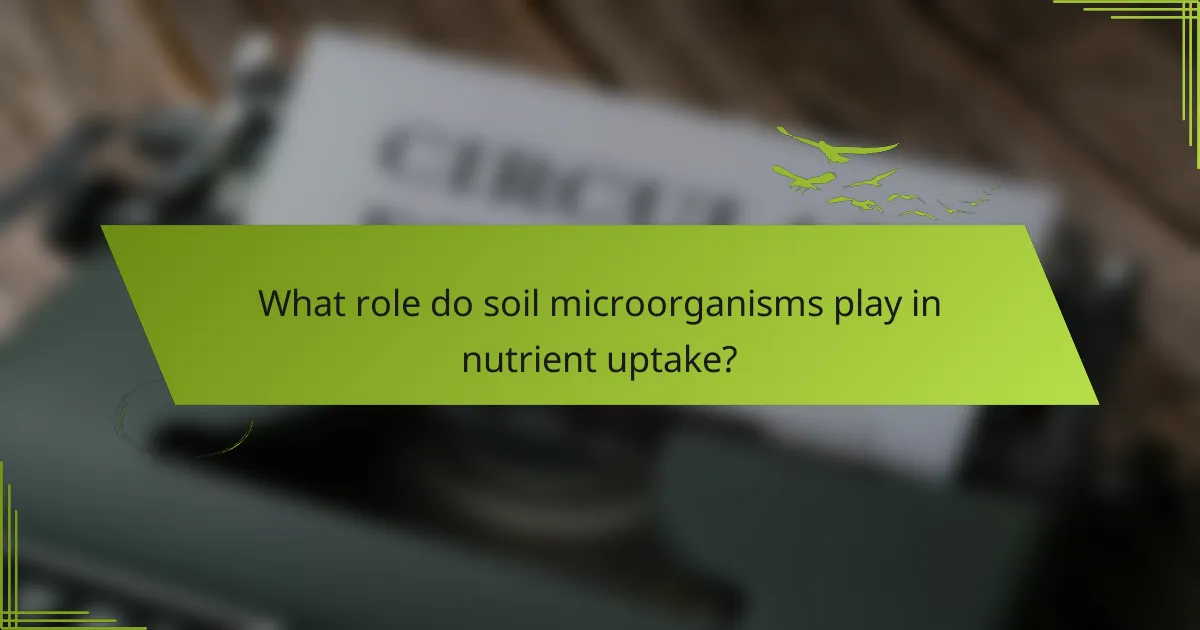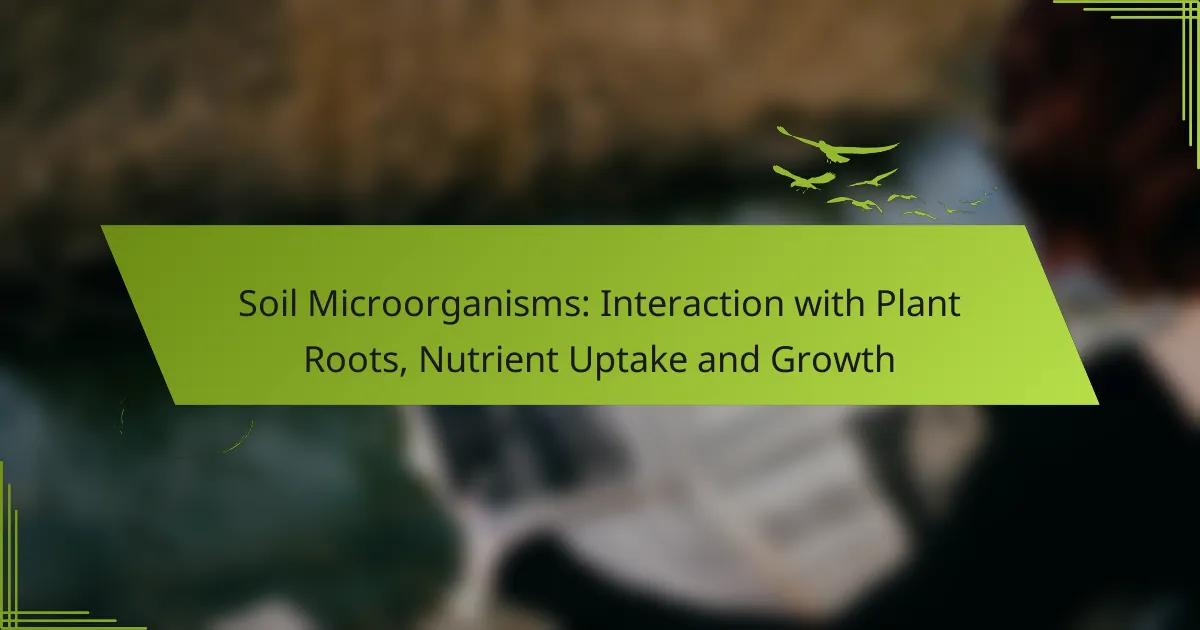Soil microorganisms are essential partners in plant growth, engaging in symbiotic relationships with roots that enhance nutrient uptake. Through their interactions, these microorganisms, including fungi and bacteria, improve the availability of vital nutrients such as nitrogen and phosphorus, ultimately promoting healthier and more resilient plants.

How do soil microorganisms interact with plant roots?
Soil microorganisms interact with plant roots primarily through symbiotic relationships that enhance nutrient uptake and promote plant growth. These interactions involve various types of microorganisms, including fungi and bacteria, which form beneficial associations with roots, improving their efficiency in nutrient absorption.
Mycorrhizal fungi enhance root growth
Mycorrhizal fungi form associations with plant roots, extending their hyphae into the soil. This increases the root surface area, allowing plants to access more water and nutrients, particularly phosphorus. In many cases, plants with mycorrhizal associations can grow significantly larger than those without.
These fungi also help improve soil structure, which can enhance water retention and aeration. For example, in agricultural settings, incorporating mycorrhizal inoculants can lead to better crop yields, especially in nutrient-poor soils.
Bacterial biofilms protect root systems
Bacterial biofilms form protective layers around plant roots, serving as a barrier against pathogens. This microbial community can outcompete harmful bacteria for resources, reducing the likelihood of root diseases. Healthy biofilms can also enhance nutrient availability by breaking down organic matter in the soil.
In practice, maintaining soil health through organic amendments can promote beneficial biofilm development. Practices such as reduced tillage and cover cropping can further support these protective bacterial communities.
Symbiotic relationships improve nutrient exchange
Symbiotic relationships between plants and soil microorganisms facilitate efficient nutrient exchange. For instance, certain bacteria can convert atmospheric nitrogen into forms that plants can utilize, while plants provide carbohydrates to these bacteria in return. This mutualistic relationship is crucial for maintaining soil fertility.
Farmers can enhance these symbiotic interactions by planting legumes, which naturally host nitrogen-fixing bacteria. This practice not only enriches the soil but also reduces the need for synthetic fertilizers, leading to more sustainable agricultural practices.

What role do soil microorganisms play in nutrient uptake?
Soil microorganisms significantly enhance nutrient uptake by plants through various mechanisms that improve the availability of essential nutrients. These microorganisms interact with plant roots, facilitating the absorption of nitrogen, phosphorus, and other vital elements necessary for growth.
Nitrogen-fixing bacteria increase availability
Nitrogen-fixing bacteria play a crucial role in converting atmospheric nitrogen into forms that plants can absorb, such as ammonium and nitrate. This process is essential for plant growth, especially in nitrogen-deficient soils, as it helps maintain soil fertility.
Common examples of nitrogen-fixing bacteria include Rhizobium, which forms symbiotic relationships with legumes, and Azotobacter, which can fix nitrogen independently. Farmers can enhance nitrogen availability by planting cover crops that host these bacteria, thus improving soil health and crop yields.
Phosphate-solubilizing microbes enhance phosphorus absorption
Phosphate-solubilizing microbes help release phosphorus from soil minerals, making it more accessible to plants. These microorganisms break down complex phosphorus compounds, converting them into soluble forms that can be easily taken up by plant roots.
Examples include species of bacteria and fungi, such as mycorrhizal fungi, which form beneficial associations with plant roots. To maximize phosphorus uptake, it is advisable to maintain soil pH levels between 6 and 7, as this range optimizes microbial activity.
Decomposers recycle organic matter for nutrient release
Decomposers, including bacteria and fungi, play a vital role in breaking down organic matter, recycling nutrients back into the soil. This process not only enriches the soil but also enhances its structure and fertility, supporting plant growth.
By composting organic waste or using cover crops, gardeners and farmers can promote the activity of decomposers, ensuring a steady supply of nutrients. Regularly adding organic matter to the soil can significantly improve nutrient availability and overall soil health.

How do soil microorganisms influence plant growth?
Soil microorganisms play a crucial role in enhancing plant growth by improving nutrient availability and promoting healthy root systems. They interact with plant roots, facilitating nutrient uptake and contributing to overall plant health and resilience.
Microbial activity boosts plant resilience
Microbial activity in the soil can significantly enhance a plant’s ability to withstand environmental stresses such as drought, salinity, and disease. Beneficial microorganisms produce compounds that help plants manage stress, leading to improved survival rates under adverse conditions.
For instance, mycorrhizal fungi form symbiotic relationships with plant roots, increasing water and nutrient absorption. This relationship can lead to stronger plants that are better equipped to handle fluctuations in their environment.
Soil health improves through microbial diversity
A diverse microbial community in the soil contributes to overall soil health, which is vital for sustainable plant growth. Different microorganisms perform various functions, such as decomposing organic matter, fixing nitrogen, and suppressing pathogens.
Maintaining microbial diversity can be achieved through practices like crop rotation, cover cropping, and reduced tillage. These practices not only enhance soil structure but also promote a balanced ecosystem that supports plant growth.
Microorganisms stimulate root development
Microorganisms stimulate root development by promoting root growth and enhancing root architecture. Certain bacteria and fungi release growth-promoting substances that encourage root elongation and branching.
For example, beneficial bacteria like Azospirillum can enhance root growth by producing auxins, which are plant hormones that regulate growth. This improved root system allows plants to access more nutrients and water, leading to healthier and more productive crops.

What are the prerequisites for healthy soil microbiomes?
Healthy soil microbiomes require a combination of suitable soil texture, adequate organic matter, and balanced nutrient availability. These factors create an environment where beneficial microorganisms can thrive and support plant growth.
Soil texture affects microbial habitats
Soil texture plays a crucial role in determining the habitat for microorganisms. Sandy soils, for instance, drain quickly and may not retain enough moisture for microbial activity, while clay soils can hold water but may limit aeration. A balanced loamy soil often provides the best environment for microbial diversity.
To optimize soil texture for microorganisms, consider amending sandy soils with organic matter to improve water retention, or incorporating sand into clay soils to enhance drainage. Regular soil testing can help identify texture-related issues that may affect microbial health.
Organic matter content supports microbial life
Organic matter is essential for sustaining microbial populations in the soil. It serves as a food source for microorganisms and contributes to soil structure, improving aeration and moisture retention. Soils rich in organic matter typically support a more diverse and active microbial community.
To increase organic matter content, incorporate compost, cover crops, or mulch into the soil. Aim for organic matter levels around 3-5% for optimal microbial activity. Regularly adding organic amendments can help maintain these levels and promote a thriving soil microbiome.

How can farmers enhance soil microorganism activity?
Farmers can enhance soil microorganism activity through practices that support microbial health and diversity. Key strategies include cover cropping, reduced tillage, and the application of organic amendments.
Cover cropping promotes microbial diversity
Cover cropping involves planting specific crops during off-seasons to protect and enrich the soil. These crops, such as clover or rye, provide organic matter and habitat for various microorganisms, leading to increased microbial diversity.
Farmers should select cover crops that are well-suited to their local climate and soil conditions. This practice not only enhances microbial life but also improves soil fertility and structure over time.
Reduced tillage improves soil structure
Reduced tillage minimizes soil disturbance, which helps maintain the habitat for beneficial microorganisms. By leaving soil undisturbed, farmers can support the natural soil structure that microorganisms thrive in.
Implementing reduced tillage can lead to better moisture retention and nutrient availability, ultimately benefiting crop yields. Farmers should consider transitioning gradually to reduced tillage to observe its effects on their specific soil types.
Organic amendments boost microbial populations
Applying organic amendments, such as compost or manure, can significantly increase microbial populations in the soil. These amendments provide essential nutrients and organic matter that stimulate microbial activity and growth.
Farmers should aim to apply organic amendments at rates that align with their soil’s nutrient needs, typically ranging from a few tons per hectare. Regular testing of soil health can help determine the appropriate type and amount of organic material to use.

What are the emerging trends in soil microbiome research?
Emerging trends in soil microbiome research focus on understanding the complex interactions between soil microorganisms and plant roots, which significantly influence nutrient uptake and plant growth. Researchers are increasingly exploring how these microbial communities can be harnessed to improve soil health and agricultural productivity.
Biotechnology applications for soil health
Biotechnology is playing a crucial role in enhancing soil health through the development of microbial-based products. These products can help restore soil fertility, improve structure, and increase organic matter content. For example, biofertilizers containing beneficial microbes can enhance nutrient availability and promote plant growth.
Additionally, bioremediation techniques utilize specific microorganisms to degrade pollutants in the soil, thereby restoring contaminated sites. This approach not only improves soil health but also supports sustainable agricultural practices.
Microbial inoculants for crop improvement
Microbial inoculants, such as rhizobacteria and mycorrhizal fungi, are increasingly used to enhance crop performance. These inoculants can improve nutrient uptake, particularly phosphorus and nitrogen, leading to better plant growth and yield. Farmers can apply these products during planting or as a soil amendment to maximize their benefits.
Choosing the right microbial inoculant depends on the specific crop and soil conditions. It’s essential to consider factors such as local climate, soil type, and the existing microbial community to ensure effective results.
Impact of climate change on soil microbiomes
Climate change significantly affects soil microbiomes, altering their composition and function. Increased temperatures and changing precipitation patterns can influence microbial activity, potentially disrupting nutrient cycling and plant growth. For instance, higher temperatures may enhance the decomposition of organic matter, leading to nutrient loss.
To mitigate these impacts, adopting sustainable land management practices is crucial. Strategies such as crop rotation, cover cropping, and reduced tillage can help maintain soil health and support resilient microbial communities in the face of climate change.
